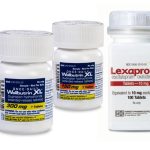Best Time To Take Lexapro For Anxiety

Anxiety is a natural response to stress, but when it becomes excessive or chronic, it can interfere with daily life and cause significant distress. Anxiety disorders are the most common mental health disorders, affecting millions of people worldwide.
There are several different types of anxiety disorders, each with its own set of symptoms:
1. Generalized anxiety disorder (GAD): People with GAD experience chronic, excessive worry about a range of everyday concerns like work, school, relationships, or health.
2. Panic disorder: Panic disorder is characterized by recurrent, unexpected panic attacks, which are intense episodes of fear and physical symptoms like rapid heartbeat, sweating, and shortness of breath.
3. Social anxiety disorder: Social anxiety disorder involves intense fear of social situations or performance situations, due to a fear of being judged or embarrassed.
4. Specific phobias: Specific phobias involve intense fear of a particular object or situation, like flying, spiders, or heights.
5. Obsessive-compulsive disorder (OCD): OCD is characterized by persistent, unwanted thoughts or obsessions, along with repetitive, compulsive behaviors or rituals intended to alleviate anxiety.
6. Post-traumatic stress disorder (PTSD): PTSD is a type of anxiety disorder that can occur after experiencing or witnessing a traumatic event, and involves symptoms like intrusive thoughts or memories, flashbacks, and avoidance of triggers.
Common symptoms of anxiety include:
1. Excessive worry or fear
2. Restlessness or irritability
3. Difficulty concentrating
4. Muscle tension or headaches
5. Insomnia or difficulty sleeping
6. Fatigue or lethargy
7. Panic attacks
Treatment for anxiety typically involves a combination of medication, therapy, and lifestyle changes. Antidepressants and anti-anxiety medications to manage symptoms.
What is Lexapro?
Lexapro (escitalopram) is a selective serotonin reuptake inhibitor (SSRI) antidepressant medication used to treat depression and anxiety disorders, such as generalized anxiety disorder, social anxiety disorder, and panic disorder.
Lexapro was first approved by the US Food and Drug Administration (FDA) in 2002 and was developed by the Danish pharmaceutical company Lundbeck. It quickly became a popular treatment option due to its effectiveness and relatively mild side effect profile compared to earlier-generation antidepressants.
Over the years, Lexapro has undergone numerous clinical trials to evaluate its safety and efficacy, and it has been found to be generally well-tolerated by most patients. It works by increasing the levels of serotonin, a neurotransmitter that regulates mood and behavior, in the brain.
In addition to its approved uses, Lexapro has also been used off-label to treat other conditions such as obsessive-compulsive disorder (OCD), post-traumatic stress disorder (PTSD), and premenstrual dysphoric disorder (PMDD). However, it should only be used as directed by a healthcare provider.
Today, Lexapro is one of the most commonly prescribed antidepressant medications in the United States, with millions of prescriptions filled each year. Its availability in generic form has made it a more affordable treatment option for patients who may have difficulty affording brand-name medications.
How Is Lexapro Taken
Lexapro (escitalopram) is typically taken once daily, either in the morning or evening, with or without food. The medication is available in tablet form and should be taken with water.
The dosage of Lexapro can vary depending on the condition being treated, the patient’s age and medical history, and other factors. It is important to follow the dosage instructions provided by the healthcare provider and to not change the dosage or stop taking the medication without first consulting with a healthcare professional.
Lexapro is usually started at a low dose, which is gradually increased over several weeks until the desired therapeutic effect is achieved. It may take several weeks for the full effects of the medication to be felt.
For major depressive disorder and generalized anxiety disorder, the recommended starting dose of Lexapro is 10 mg once daily, which may be increased to a maximum dose of 20 mg once daily if needed. For patients with hepatic impairment or who are over the age of 65, a lower starting dose of 5 mg once daily may be recommended.
For obsessive-compulsive disorder, the recommended starting dose of Lexapro is 10 mg once daily, which may be increased to a maximum dose of 20 mg once daily if needed.
For panic disorder, the recommended starting dose of Lexapro is 5 mg once daily, which may be increased to a maximum dose of 10 mg once daily after one week.
It is important to take Lexapro consistently at the same time each day to maintain a steady level of the medication in the body. If a dose is missed, it should be taken as soon as possible, unless it is close to the time for the next scheduled dose. In this case, the missed dose should be skipped and the regular dosing schedule should be resumed. It is not recommended to double the dose to make up for a missed dose.
Patients should also avoid abruptly stopping the medication, as this can lead to withdrawal symptoms. A healthcare provider should be consulted before discontinuing Lexapro to determine the best course of action.
Best Time To Take Lexapro For Anxiety
The best time to take Lexapro (escitalopram) for anxiety may vary from person to person and can be based on individual factors such as their response to the medication and any side effects experienced. However, in general, Lexapro is usually taken once daily, either in the morning or at night.
Some people prefer to take Lexapro in the morning, as it may help them feel more energized throughout the day and improve their mood. Others prefer to take it at night, as it may cause drowsiness and improve their sleep quality. It’s important to consult with a healthcare provider to determine the best time to take Lexapro based on an individual’s unique needs and circumstances.
It’s also important to note that it may take several weeks for Lexapro to start working effectively for anxiety, and it should be taken as directed by a healthcare provider. Abruptly stopping the medication can cause withdrawal symptoms, and it’s important to gradually reduce the dosage under the guidance of a healthcare provider if the medication needs to be discontinued.
Lexapro Side Effects
Lexapro (escitalopram) can cause side effects. Some of the common side effects of Lexapro include:
1. Nausea and vomiting
2. Headache
3. Diarrhea or constipation
4. Dizziness
5. Dry mouth
6. Insomnia or excessive sleepiness
7. Sweating
8. Sexual dysfunction, such as decreased libido, difficulty achieving orgasm, or erectile dysfunction
9. Weight gain
10. Increased appetite
11. Fatigue or tiredness
In rare cases, Lexapro can cause more serious side effects, such as suicidal thoughts or behavior, serotonin syndrome, or an allergic reaction. It’s important to contact a healthcare provider immediately if any of these symptoms are experienced.
It’s important to note that not everyone will experience side effects from Lexapro, and some people may experience different or more severe side effects than others. It’s important to discuss any concerns or side effects with a healthcare provider, who may adjust the dosage or recommend a different medication if necessary.





